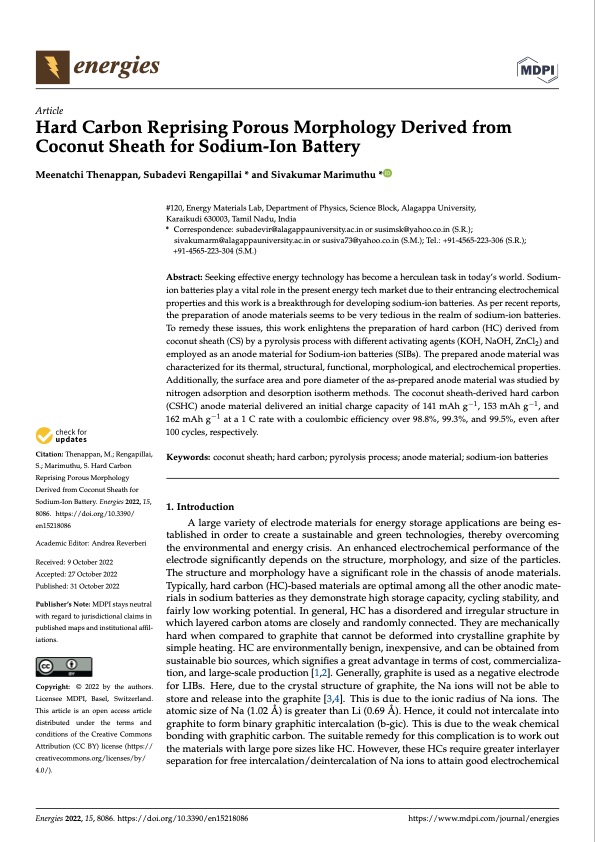
PDF Publication Title:
Text from PDF Page: 001
energies Article Hard Carbon Reprising Porous Morphology Derived from Coconut Sheath for Sodium-Ion Battery Meenatchi Thenappan, Subadevi Rengapillai * and Sivakumar Marimuthu * Citation: Thenappan, M.; Rengapillai, S.; Marimuthu, S. Hard Carbon Reprising Porous Morphology Derived from Coconut Sheath for Sodium-Ion Battery. Energies 2022, 15, 8086. https://doi.org/10.3390/ en15218086 Academic Editor: Andrea Reverberi Received: 9 October 2022 Accepted: 27 October 2022 Published: 31 October 2022 Publisher’s Note: MDPI stays neutral with regard to jurisdictional claims in published maps and institutional affil- iations. Copyright: © 2022 by the authors. Licensee MDPI, Basel, Switzerland. This article is an open access article distributed under the terms and conditions of the Creative Commons Attribution (CC BY) license (https:// creativecommons.org/licenses/by/ 4.0/). #120, Energy Materials Lab, Department of Physics, Science Block, Alagappa University, Karaikudi 630003, Tamil Nadu, India * Correspondence:subadevir@alagappauniversity.ac.inorsusimsk@yahoo.co.in(S.R.); sivakumarm@alagappauniversity.ac.in or susiva73@yahoo.co.in (S.M.); Tel.: +91-4565-223-306 (S.R.); +91-4565-223-304 (S.M.) Abstract: Seeking effective energy technology has become a herculean task in today’s world. Sodium- ion batteries play a vital role in the present energy tech market due to their entrancing electrochemical properties and this work is a breakthrough for developing sodium-ion batteries. As per recent reports, the preparation of anode materials seems to be very tedious in the realm of sodium-ion batteries. To remedy these issues, this work enlightens the preparation of hard carbon (HC) derived from coconut sheath (CS) by a pyrolysis process with different activating agents (KOH, NaOH, ZnCl2) and employed as an anode material for Sodium-ion batteries (SIBs). The prepared anode material was characterized for its thermal, structural, functional, morphological, and electrochemical properties. Additionally, the surface area and pore diameter of the as-prepared anode material was studied by nitrogen adsorption and desorption isotherm methods. The coconut sheath-derived hard carbon (CSHC) anode material delivered an initial charge capacity of 141 mAh g−1, 153 mAh g−1, and 162 mAh g−1 at a 1 C rate with a coulombic efficiency over 98.8%, 99.3%, and 99.5%, even after 100 cycles, respectively. Keywords: coconut sheath; hard carbon; pyrolysis process; anode material; sodium-ion batteries 1. Introduction A large variety of electrode materials for energy storage applications are being es- tablished in order to create a sustainable and green technologies, thereby overcoming the environmental and energy crisis. An enhanced electrochemical performance of the electrode significantly depends on the structure, morphology, and size of the particles. The structure and morphology have a significant role in the chassis of anode materials. Typically, hard carbon (HC)-based materials are optimal among all the other anodic mate- rials in sodium batteries as they demonstrate high storage capacity, cycling stability, and fairly low working potential. In general, HC has a disordered and irregular structure in which layered carbon atoms are closely and randomly connected. They are mechanically hard when compared to graphite that cannot be deformed into crystalline graphite by simple heating. HC are environmentally benign, inexpensive, and can be obtained from sustainable bio sources, which signifies a great advantage in terms of cost, commercializa- tion, and large-scale production [1,2]. Generally, graphite is used as a negative electrode for LIBs. Here, due to the crystal structure of graphite, the Na ions will not be able to store and release into the graphite [3,4]. This is due to the ionic radius of Na ions. The atomic size of Na (1.02 Å) is greater than Li (0.69 Å). Hence, it could not intercalate into graphite to form binary graphitic intercalation (b-gic). This is due to the weak chemical bonding with graphitic carbon. The suitable remedy for this complication is to work out the materials with large pore sizes like HC. However, these HCs require greater interlayer separation for free intercalation/deintercalation of Na ions to attain good electrochemical Energies 2022, 15, 8086. https://doi.org/10.3390/en15218086 https://www.mdpi.com/journal/energiesPDF Image | Morphology Derived Coconut Sheath for Sodium-Ion Battery

PDF Search Title:
Morphology Derived Coconut Sheath for Sodium-Ion BatteryOriginal File Name Searched:
energies-15-08086.pdfDIY PDF Search: Google It | Yahoo | Bing
Salgenx Redox Flow Battery Technology: Salt water flow battery technology with low cost and great energy density that can be used for power storage and thermal storage. Let us de-risk your production using our license. Our aqueous flow battery is less cost than Tesla Megapack and available faster. Redox flow battery. No membrane needed like with Vanadium, or Bromine. Salgenx flow battery
| CONTACT TEL: 608-238-6001 Email: greg@salgenx.com | RSS | AMP |